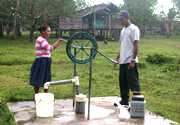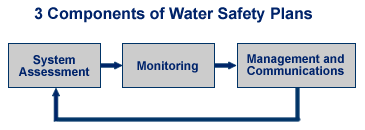Community Water Systems and Water Safety Plans
 Human health and well-being are strongly affected by the environment in which we live — the air we breathe, the water we drink, and the food and nutrients we eat. Community water systems and water safety plans are important ways to ensure the health of the community.
Human health and well-being are strongly affected by the environment in which we live — the air we breathe, the water we drink, and the food and nutrients we eat. Community water systems and water safety plans are important ways to ensure the health of the community.
In many places, communities lack the capacity to effectively adapt their current systems for water, sanitation, and hygiene to the community's changing needs (population growth, changes in water quality).
According to the World Health Organization, the objectives of a water safety plan are to ensure safe drinking water through good water supply practices, which include:
- Preventing contamination of source waters;
- Treating the water to reduce or remove contamination that could be present to the extent necessary to meet the water quality targets; and
- Preventing re-contamination during storage, distribution, and handling of drinking water.

Figure Courtesy of WHO
- Page last reviewed: December 17, 2015
- Page last updated: December 17, 2015
- Content source:


 ShareCompartir
ShareCompartir